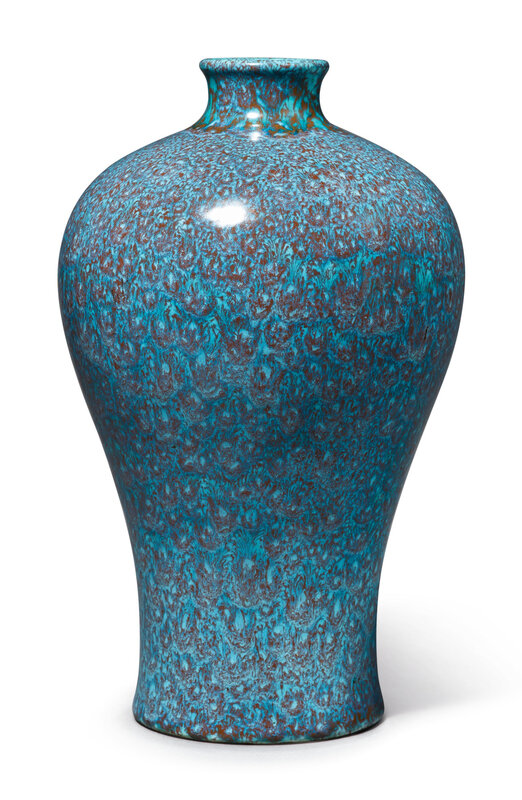A rare 'robin's egg'-glazed meiping, Yongzheng seal mark and period (1723-1735)
Lot 621. A rare 'robin's egg'-glazed meiping, Yongzheng seal mark and period (1723-1735). Height 8 3/4 in., 22 cm. Estimate 100,000 — 150,000 USD. Lot Sold 680,000 USD. © Sotheby's.
superbly potted with a tapering body sweeping up to a broad rounded shoulder, surmounted by a short, waisted neck and lipped rim, covered overall with a brilliant glaze with liberally applied vibrant turquoise dappled over a bronze-colored ground, the base incised with a four-character reign mark beneath the mottled glaze.
Provenance: Collection of John Milton Bonham (1835-1897).
The present strongly mottled turquoise glaze represents a rare variation of the much more common ‘robin’s egg’ glaze. Characterized by more intense turquoise/brown contrasts, the present vase is reminiscent of a sub-category referred to as 'peacock feather’. It seems to represent an early Yongzheng version, before the more evenly dappled ‘robin’s egg’ glaze came into use.
Examples with this variation of the 'robin's egg' glaze are rare, however, compare a number of vases bearing incised four-character Yongzheng marks; a small flower receptacle in the Qing Court Collection is illustrated in The Complete Collection of Treasures of the Palace Museum. Monochrome Porcelain, Hong Kong, 1999, pl. 187; a mallet-form vase in the National Museum, Beijing, is illustrated in Studies of the Collections of the National Museum of China. Qing Porcelain, Beijing, 2006, pl. 67; and a garlic-neck vase in the Zande Lou Collection is illustrated in Qing Imperial Monochromes The Zande Lou Collection, Hong Kong, 2005, pl. 20.
The majority of meiping applied with 'robin's egg' glazes are unmarked and are generally attributed to the reign of the Qianlong Emperor or the 18th century, making this vase a particularly rare example. Compare a larger (34cm) Qianlong mark and period meiping sold in our London rooms, 10th December 1991, lot 293, and again in our Hong Kong rooms, 1st May 2001, lot 520.
Sotheby's. Important Chinese Art, New York, 10 september 2019

/https%3A%2F%2Fprofilepics.canalblog.com%2Fprofilepics%2F1%2F0%2F100183.jpg)
/https%3A%2F%2Fstorage.canalblog.com%2F03%2F02%2F119589%2F96711876_o.jpg)
/https%3A%2F%2Fstorage.canalblog.com%2F11%2F31%2F119589%2F94773502_o.jpg)
/https%3A%2F%2Fstorage.canalblog.com%2F20%2F83%2F119589%2F94772815_o.jpg)
/https%3A%2F%2Fstorage.canalblog.com%2F26%2F72%2F119589%2F75604929_o.jpg)
/https%3A%2F%2Fstorage.canalblog.com%2F59%2F60%2F119589%2F26458628_o.jpg)





/image%2F1371349%2F20240329%2Fob_17ee91_115-1.jpg)
/image%2F1371349%2F20240323%2Fob_65a2da_434238029-1637329100370436-25280776982.jpg)
/http%3A%2F%2Fstorage.canalblog.com%2F69%2F46%2F119589%2F129423593_o.jpg)
/http%3A%2F%2Fstorage.canalblog.com%2F63%2F90%2F119589%2F129042528_o.png)